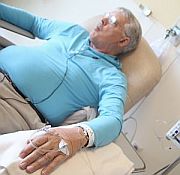
TUESDAY, April 7, 2015 (HealthDay News) — Doctors may charge uninsured patients anywhere from two to 43 times what private insurance plans or Medicare pay for chemotherapy drugs, a new study estimates.
Researchers said the findings, reported in the April issue of Health Affairs, highlight a fundamental inequity.
“It seems that uninsured patients should not be charged more than an insurance company would pay for the same services,” said lead researcher Stacie Dusetzina, an assistant professor at the University of North Carolina at Chapel Hill’s Gillings School of Global Public Health.
It’s no surprise, she said, that uninsured patients may be charged more than the negotiated, discounted rates paid by insurance companies and Medicare — the federal health insurance program for older Americans.
“What was surprising was the magnitude of the difference,” Dusetzina said.
Most of the charges for chemo drugs were double what insurers paid, she said. But charges for some drugs were up to 43 times what Medicare paid, and five times what private insurers paid.
“Obviously, it would be extremely challenging for most people to even attempt to pay the prices set for infused chemotherapy that we see here,” Dusetzina said.
And while the Affordable Care Act — also known as “Obamacare” — made it mandatory for Americans to have health insurance or pay a penalty, many people remain uninsured, Dusetzina noted.
She pointed, in particular, to states that chose not to expand Medicaid, the government health insurance program for the poor. That has left some lower-income Americans in a quandary: They do not qualify for Medicaid, and they can’t afford the premiums on private health plans.
Studies have already shown that U.S. hospitals typically charge much more for a range of services than hospitals in other countries — and also that within the United States, charges can vary hugely from one hospital to another.
But until recently, researchers have had little access to data on individual doctors’ charges. Last year, however, Medicare and Medicaid began releasing that information for public use.
Dusetzina’s team took advantage of that. Using the government data, the researchers looked at what doctors charged for chemotherapy drugs in 2012. They compared the charges with what Medicare and large private insurers actually paid for those drugs.
On average, the researchers found, Medicare paid only 40 percent of what doctors charged for chemo, while private insurers paid 56 percent.
People without insurance, however, could face whatever the doctor’s office billed them. And those prices would likely stretch far beyond what most could pay, the study authors said.
For example, the typical charge for the chemo drug oxaliplatin (Eloxatin) was more than $6,700 for one infusion, the researchers found. Medicare actually paid around $3,000, while private insurers paid $3,600, on average.
Even office visits were pricey for uninsured cancer patients. They faced charges ranging from $129 to $391. Medicare, meanwhile, paid $65 to $188, and private insurers paid $78 to $246 for the same services.
Still, the study looked only at doctors’ average charges — and not what insured people actually paid for chemo, said John Holahan, a fellow at the Urban Institute’s Health Policy Center, in Washington, D.C.
“The uninsured often don’t end up paying,” said Holahan, who was not involved in the study.
Some doctors or hospitals offer free or lower-cost treatment to the uninsured, or will set up payment plans, he noted. In other cases, providers “try their best to collect,” he said, but end up taking a loss.
In any case, Holahan said, it’s better for everyone if patients have insurance.
Dusetzina agreed that it’s not clear how often uninsured patients are held liable for chemotherapy charges.
She pointed to one 2007 study — though it looked at uninsured patients’ liability for all outpatient care, not just chemo. It found that 35 percent to 53 percent of uninsured patients paid more than insurance plans did, Dusetzina said. Another quarter paid nothing, and often had their bills sent to collection agencies.
Expanding insurance coverage to more Americans is part of the remedy, Dusetzina said. But “rational pricing” on the part of hospitals and doctors is another, she said.
“The prices set for services do not seem to be related to anything,” she said.
Figuring out the reasons for those variations, and somehow reducing them, is important, Dusetzina said.
More information
The U.S. government’s Healthcare.gov has resources for finding health coverage.
Copyright © 2025 HealthDay. All rights reserved.

